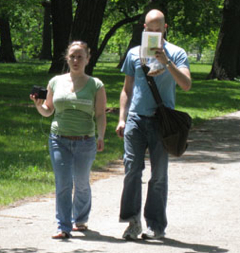
Mark Glaser is traveling this week, but we’re happy to have students from the Medill School of Journalism at Northwestern University filling in again as special guest bloggers. They were in a class studying “locative media,” a new form of journalism that tells stories via cell phones based on your location.
Lojo Connect, our ten-week project that has explored ways that newsrooms can use location-based storytelling, including online interactive maps and GPS-driven stories, is coming to a close. You can read our previous posts on MediaShift to learn more about our project and limitations we encountered along the way.
On May 31, our team road-tested our location-based story with a public event in Washington Park, the proposed site of the Olympic Stadium if Chicago wins the 2016 Summer Games bid. Using HP iPAQ mobile devices, our participants listened to several GPS-triggered stories while walking through the park. Stories included narratives about the park’s rich historical role in the 1893 World’s Fair and Columbian Exposition, as well as the community’s thoughts about the social and economic impacts that the Olympics could bring.

By combining the feedback we received from our public event participants with insights from our industry research, we created the following list of big takeaways from our project. Although the technology is still evolving, we believe there are ways for news organizations to begin offering location-based content immediately.
12. Think geographically.
Geography is a key tool for making content relevant to media users. It is becoming a powerful interface for information search and organization. News organizations should “geo-tag,” or embed geographic data in stories, so they can be easily identified by their relevant locations. Rather than searching by keyword, people can now browse a digital map for relevant information for a particular location. For example, Google Earth now includes a New York Times layer that allows users to track news geographically.
11. Capitalize on mobile technology for geo-content.
Mobile technology is ideal for delivering geographically relevant content. And the recently announced GPS-enabled iPhone will certainly help raise awareness of geo-targeted services. Key advantages of mobile devices include portability, location awareness that can be used to customize content, and the fact that people almost always have their cell phones with them. Mobile devices make it increasingly possible to target content for users based on their location or geographic interests.

In fact, mobile phone messaging that is based on a recipient’s location already exists. For example, JotYou allows users to send text messages that are only delivered when a recipient enters a previously specified location. With this kind of technology, news organizations could let people opt-in to get the latest score of a Cubs game as they drive by Wrigley Field or receive other geo-targeted breaking news alerts.
10. The media should be experimenting now with mobile content.
U.S. media companies have been relatively slow to develop mobile content. Foreign competitors experimented with electronic newspaper kiosks and established mobile newspaper versions several years ahead of major American media companies. Also, consumers are increasingly “urban nomads” who are not tied to their offices and homes.
There’s a push for Internet experiences on mobile devices that are more similar to experiences on the desktop computers in terms of look and usability. Google’s new Android open mobile operating system could help make this transition more seamless.
9. Streamline content delivery.
Consumers may be reluctant to use podcasts and other portable content because the delivery process is time-intensive and often takes multiple steps. Streamlining this process might increase the number of users. As WiFi technology improves and becomes more widely available, news organizations should also try for on-demand and wireless content delivery if possible. Also, sites like Skweezer) allow web pages to be optimized for mobile devices.
8. Target a young adult audience.
Young adults are particularly avid users of mobile technology. For them, mobile technology’s value will only increase as social networks go mobile. They also tend to be more tech-savvy early adopters and less likely to worry about privacy issues and location tracking because they have grown up in a world with Facebook and other applications that make people’s private lives very public.
7. Maximize existing resources.
Mobile journalists are proliferating in newsrooms and are ideal producers of locative content because they are already outfitted with the necessary technology, tools and mindset. Not only are they in the field with portable laptops, voice recorders and video cameras, they are also on the hunt for hyper-local content. News organizations can easily re-purpose audio, video and images from other kinds of stories.
6. Harness the power of audio.
Audio has been under-appreciated, but now that portable devices are becoming more popular for consuming content, people need to overcome the notion that audio is only for radio. Audio is powerful, immersive and often useful because people tend to use portable devices while multitasking.

News organizations should remember that walking tours often work best when they are mostly audio-based. The participants in our public event consistently told us that the photographs we included in the multimedia story distracted them and distanced them from the physical surroundings. Video is still very powerful, but should be reserved for the web for location-based storytelling.
The New York Times, for example, has started to use the audio tour format for storytelling. Their website offers several audio narratives of Manhattan neighborhoods, including tours of the places that defined P.T. Barnum’s New York and the Underground Railroad routes in Brooklyn.
5. Different locative stories deserve different treatment.
Locative stories are more likely to catch on if they’re organic experiences. Consumers will be more likely to embrace this storytelling form if it fits the flow of their daily lives and does not force them into a location and an experience. Breaking news alerts trigged by a user’s current location could be really valuable. For example, users could be alerted of a big demonstration taking place up ahead and decide whether to avoid it or to attend.
4. Avoid “Google Maps fatigue.”
Newspapers widely and frequently use interactive online maps now. More information is being attached to geographic coordinates, but this information needs to be better organized and differentiated, so that content avoids looking repetitive.
3. Explore location-based advertising.
Location-based advertising has been called the Holy Grail of mobile marketing. CBS and Loopt recently announced plans for localized banner ads on certain CBS mobile sites. The ads are only carried by select mobile subscribers and are available to owners of GPS-enabled phones who opt in. More partnerships of this kind are expected, although privacy concerns persist.
2. Encourage user feedback and community involvement.
We live in an era of user-generated content and participation. Young adults, in particular, are used to sites that allow comments, ratings or reviews, and sharing. In offering locative content, news organizations should capitalize on this trend. Following the lead of community storytelling initiatives, such as The Organic City in Oakland, Calif., newsrooms should engage community members in story development and promotion.
1. Just do it!
Locative journalism is relatively new, but holds a great deal of promise. We’re accustomed to using linear interfaces, such as alphabetized directories and timelines, to organize and access information. But our experiences in the real, physical and non-digitized world are usually not linear. They’re spatial, dynamic and intuitive. Locative technology has the power to capitalize on that instinct.
Hilary Powell, a native of Indianapolis, is a graduate student at Medill, majoring in new media. She is interested in digital journalism that combines television reporting with online news production.
Hope Needles studied International Affairs and Statistics at The George Washington University. She has interned for NPR, Dateline NBC, Newser.com, and recently completed a residency for the BBC in London.

Good to see the locative media trend continuing. Excellent use here and a good guide for how to plan out such projects.
Interesting post and great resources for journalists!
Thanks for the list!
Thanks for this excellent project !
As CEO of a company specialized in such subjects, for more than 4 years, I completely agree with your conclusions.
I would like to add two points : the importance of all the means used to strenghtening the community of authors (because it is extremely hard to keep regular authors and to help them to post content over a long period) and the issue linked to the remuneration of these authors, that remains to resolve.
Thanks I was just trying to explain that in a Locomotive industry, It’s always better for an employee to complete their work with confidence and under the direction of a supervisor.
Please, PBS, don’t learn the lessons of Clickbait. See if you can’t resist the urge to make a list for everything.
Please.